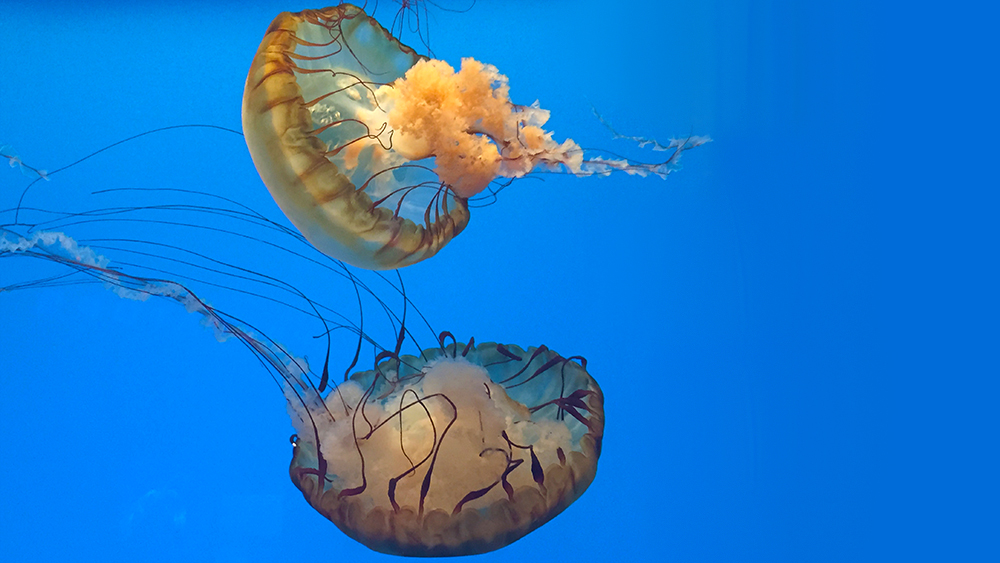Like all animals, “simple” invertebrates such as the jellyfish continue to amaze zoologists.1,2
Recently, scientists have trained a tiny species of box jellyfish (Tripedalia cystophora) to see and avoid obstacles.
No bigger than a fingernail, these seemingly simple jellies have a complex visual system with 24 eyes embedded in their bell-like body. Living in mangrove swamps, the animal uses its vision to steer through murky waters and swerve around underwater tree roots to snare prey. Scientists demonstrated that the jellies could acquire the ability to avoid obstacles through associative learning, a process through which organisms form mental connections between sensory stimulations and behaviors.3
Behavioral scientists working in the field of learning find there are two main learning categories: “Nonassociative learning includes phenomena such as habituation: if you gently poke an animal several times, it will eventually stop recoiling or shying away. Associative learning is more complex because it requires an animal to connect cues in its environment...”4
It was thought that advanced learning such as associative learning required a centralized brain, but jellyfish are designed with an amazingly complex nerve net. “[Jellyfish] nerve nets are peculiar in that many of the synapses [a minute gap between two nerve cells] have vesicles of neurotransmitters on both sides, allowing transmission across the synapse in either direction.”5 This highly complex structure is evidently sufficient for the creature’s learning, in tandem with sets of eyes—some of which are like vertebrate eyes.1,3
But how does one go about understanding and evaluating how a jellyfish learns? According to a summary by ScienceDaily, the research team had a clever method.
[The research team] dressed a round tank with gray and white stripes to simulate the jellyfish's natural habitat, with gray stripes mimicking mangrove roots that would appear distant. They observed the jellyfish in the tank for 7.5 minutes. Initially, the jelly swam close to these seemingly far stripes and bumped into them frequently. But by the end of the experiment, the jelly increased its average distance to the wall by about 50%, quadrupled the number of successful pivots to avoid collision and cut its contact with the wall by half. The findings suggest that jellyfish can learn from experience through visual and mechanical stimuli.3
As is almost always the case, evolutionists give glory to the creation, not the Creator, by stating that cellular mechanisms were invented by evolution in deep evolutionary time. This is not an explanation, of course, but simply hand waving away evidence God put in creation.
"It's surprising how fast these animals learn; it's about the same pace as advanced animals are doing," says [senior author Anders Garm of the University of Copenhagen]. "Even the simplest nervous system seems to be able to do advanced learning, and this might turn out to be an extremely fundamental cellular mechanism invented at the dawn of the evolution nervous system."3
While evolutionists claim these irreducibly complex systems are due to blind and purposeless evolution, this “advanced learning” in what was previously thought to be a “simple creature” reflects purposeful and novel special creation by an all-wise Creator.6
The researchers stated the study “sheds light on the evolutionary roots of learning and memory,” but it does nothing of the sort. There are no evolutionary roots of learning and memory. They have instead discovered something quite incredible. The research on the tiny box jellyfish revealed they can learn from experience and not just react to external stimuli.
Truly, God’s creation is “clearly seen.”7
References
- Sherwin, F. 2007. The Eyes of Creation. Acts & Facts. 36 (7).
- Thomas, B. What Does it Take to Make a Jellyfish? Creation Science Update. Posted on ICR.org August 10, 2012, accessed October 3, 2023.
- Jellyfish, with no central brain, shown to learn from past experience. Cell Press via ScienceDaily. Posted on sciencedaily.com September 22, 2023, accessed October 3, 2023.
- Bartels, M. These Adorable Jellyfish Show Learning Doesn’t Even Require a Brain. Scientific American. Posted on scientificamerican.com September 22, 2023, accessed October 2, 2023.
- Hickman, C. et al. 2020. Integrated Principles of Zoology. 18th edition. McGraw-Hill Publishers. 270.
- Sherwin, F. Butterflies Can Remember. Creation Science Update. Posted on ICR.org August 24, 2023, accessed October 3, 2023.
- Romans 1:20
* Dr. Sherwin is science news writer at the Institute for Creation Research. He earned an M.A. in zoology from the University of Northern Colorado and received an Honorary Doctorate of Science from Pensacola Christian College.





















